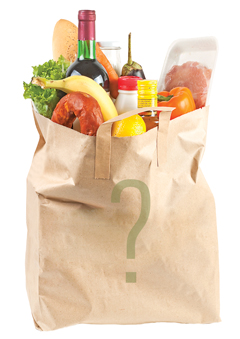With a blended family that includes five school-age children, Catherine Fales is busy making lunches every day.
One kid wants his sandwich on a sub roll. Another eats only white bread. Two will eat whole wheat, but still another kid needs gluten-free. “We have four different kinds of bread, just for lunches,” said Fales, who lives in western Henrico County.
Providing for the seven varying appetites and seven busy schedules in the household requires strategy and planning, but Fales has a system. She shops at Costco for bulk supplies; husband Eric picks up Relay Foods shipments on Mondays. Thursdays are for shopping at Trader Joe’s while several of the kids have sports practices, and occasionally someone pops into Kroger for whatever they’ve forgotten.
Fales considers herself lucky to have so many options for groceries.
And the options are expanding, because, apparently, Richmond has a reputation.
In the past few years, the market has become recognized as a foodie hot spot, with nationally acclaimed restaurants and upscale grocery stores making it possible to procure the exotic and trendy ingredients we find in our favorite meals.
For example, Southern Seasons opened last summer on Staples Mill Road. There’s an entire aisle for cheese straws, and another just for barbecue sauce. You can’t buy a gallon of milk or an apple there, but the 49,000 square-foot space stays packed with curious shoppers and those visiting the in-house restaurant and cooking school.
Even our traditional grocery stores have expanded their offerings in recent years and when possible, have expanded floor space to keep up.
Kroger, for example, has announced plans to expand its Midlothian Turnpike store near state Route 288 in Chesterfield County (an area that already includes a new Martin’s) to more than 110,000 square feet. And while that seems huge, it still pales in comparison to the Kroger Marketplace on Staples Mill Road and the Kroger Marketplace at Stonebridge, which opened in 2012 at the site of the former Cloverleaf Mall. Both of these measure out around 123,000 square feet.
Kroger, Martin’s, and Walmart have grown their existing facilities and opened new stores. The coming year should bring competition from upscale Wegman’s (slated to open in summer of 2016 in West Broad Marketplace, just east of the Goochland County line) and lower-priced chain Aldi.
The grocery arena is ever-shifting. According to the most recent rankings by Food World, Martin’s and Food Lion hold the top two spots among Richmond-area retailers. But both of those chains lost some market share over 2013, and third-ranked Walmart and fourth-ranked Kroger gained market share.
Not everyone wants to shop at a super-sized grocery store though. The flip-side of these mega-stores is Richmond’s independent grocer movement, which has gained traction in the past few years. Grocers, such as the Little House Green Grocery, Harvest Grocery + Supply, Union Market, and Richmond Food Co-op offer local products.
Other options for shopping have come along recently, including services such as Relay Foods, where you order online and pick up the goods at a certain time and location, and Dominon Harvest, a home-grown company founded by VCU graduate Howard Brown. Dominion Harvest specializes in delivering fresh, seasonal produce and more from local sustainable farms directly to your home.
Also growing in popularity are Richmond-area farmers’ markets, emphasizing fresh, organic, and healthy choices. Currently, there are more than a dozen around the area. Here, shoppers find fresh, local choices, and family farms have a chance to show their stuff. Old Church Creamery in Manquin started as a small dairy farm in 2008. Today, in addition to milk, the farm sells yogurt, cheese, and kefir (a fermented milk drink) at six area farmers markets, said owner Catherine Maria Long.
“In the last two years, we have expanded our wholesale activity by selling to more than ten stores in Richmond that stretch from Church Hill to Goochland. We are also in three stores in Charlottesville and three stores in Williamsburg.”
 Old Church Creamery meets customer demands by eliminating all pesticide use, petroleum-based fertilizer use, using non-GMO feeds, and producing milk that is free of steroids, hormones, and antibiotics. “Residents of Richmond and the surrounding counties have flocked to area farmers’ markets to obtain fresh, local dairy products,” Long said, noting that the trend of growing consumer demand for local products in area stores mimics what they have witnessed at the farmers’ markets.
Old Church Creamery meets customer demands by eliminating all pesticide use, petroleum-based fertilizer use, using non-GMO feeds, and producing milk that is free of steroids, hormones, and antibiotics. “Residents of Richmond and the surrounding counties have flocked to area farmers’ markets to obtain fresh, local dairy products,” Long said, noting that the trend of growing consumer demand for local products in area stores mimics what they have witnessed at the farmers’ markets.
Another flourishing niche includes the Asian and Latin markets that serve Richmond’s increasingly diverse populations – and its adventurous eaters.
The U.S. Grocery Shopper Trends 2014 report, published by the Food Marketing Institute, noted that people are shopping around more, often frequenting 2.5 channels, or stores, and fragmenting shopping duties among family members. The study also said that boomers are more likely to plan ahead and stick to lists, while millennials are more apt to be picking up food for their next meal. (The jury is still out on the middle-ground.)
And while shoppers will say they’re looking for healthy items and have embraced the local food movement, Food World, a Maryland-based industry publication, reports that the top ten edible items sold in area grocery stores come from categories that aren’t exactly healthful: soft drinks, sports drinks, and salty snacks.
Overall, there does seem to be an increased emphasis on wellness and shopping for minimally processed foods, with many people opting to eat local, in spite of the cost.
Fales, with her family of seven, estimates she spends a little more than a thousand per month on groceries, which includes primarily organic foods. Noting her commitment to organic, that figure is higher than the national average, according to the Food Marketing Institute, which lists the 2014 weekly national averages for grocery-spending like this: household size equals one – $66.46, two – $96.98, three to four – $128.71, five or more – $151.30.
A recent Food World survey estimated annual food sales in central Virginia at more than $3.44 billion – and it’s likely to grow with new stores and options.
With so much expansion, can Richmond support this grocery-store paradise?
Commercial real estate organization Colliers International recently mused in an article, “Richmonders haven’t exactly been going hungry in recent years, having plenty of places to stock up on groceries, but they are about to get a lot more options. The grocery wars are heating up like never before and it’s going to get bloody before some inevitable casualties fall by the wayside.”
New stores might draw in curious shoppers for a time or two, but many people say their shopping habits are already established.
“I don’t think the new stores coming to the area will change much for me,” said Christine Stefanelli, who lives in the Brandermill area. “I tend to try a new spot for small things, then maybe one large trip – but I always find myself back at Kroger.”
Stefanelli, shopping for a family of
five, found she got distracted at big-box stores, coming home with things she didn’t need. So she tries to stick to traditional grocery stores.
Indeed, there are plenty of those to choose from in Richmond.

Food-Store Factoids Anyone?
- In 1987, Richmond-based Ukrop’s Super Markets launched the first loyalty card program in the country.
- While Piggly Wiggly was the first self-service store (opened in 1916), the first supermarket was King Kullen Grocery Company in New York in 1930.
- Supermarkets began scanning in 1974. The first item scanned in a commercial environment was a pack of Wrigley chewing gum in Marsh Supermarkets in Ohio on June 26, 1974.
- Sylvan Goldman of Oklahoma City invented the shopping cart in 1937.
- C.A. Swanson & Sons introduced the frozen “TV dinner” in 1954, the year RCA marketed the first color television sets.
Groceries by the Numbers
The Arlington-based Food Marketing Institute reports:
- Average number of trips per week consumers make to the supermarket: 1.6
- Average number items carried in a supermarket: 43,844
- Median store size: 46,500 square feet
 What’s in a Name?
What’s in a Name?
How many different kinds of grocery stores do you shop?
It might be helpful to get a handle on the lingo first.
Traditional Supermarket Stores offering a full line of groceries, meat, and produce. These stores typically carry anywhere from 15,000 to 60,000 products and may offer a service deli, a service bakery, and/or a pharmacy.
Fresh Format Different from traditional supermarkets and traditional natural food stores, fresh stores emphasize perishables
and offer center-store assortments that differ from those of traditional retailers – especially
in the areas of ethnic, natural, and organic. Think Whole Foods, The Fresh Market, and
Tom Leonard’s Farmer’s Market.
Superstore A supermarket with at least 30,000 square feet and an expanded selection of non-food items. Specialty departments and extensive services are offered.
Warehouse Store Grocery store with limited service that eliminates frills and concentrates on price appeal. Items often are displayed in their original shipping cartons rather than placed individually on shelves. Stores may also sell bulk food and large size items. And yes, there also are super warehouse stores that are a hybrid of traditional supermarket and warehouse store.
Limited-Assortment Store A low-priced grocery store that offers a limited assortment of branded, center-store, and perishable items. Examples include Aldi and Trader Joe’s.
Wholesale Club A membership retail/
wholesale hybrid with a varied selection and limited variety of products presented in a warehouse-type environment. These 120,000 square-foot behemoths feature a grocery line dedicated to large sizes and bulk sales. Memberships include both business accounts and consumer groups. Local examples include Sam’s Club, Costco, and BJ’s.
Supercenters A hybrid of a large supermarket and a mass merchandiser, supercenters offer a variety of food, as well as non-food merchandise. These stores average more than 170,000 square feet and typically devote as much as forty percent of the space to grocery items. Think Walmart Supercenter and Super Target.
Dollar Store A small-store format that traditionally sold staples and knick-knacks, but now offers consumable items at aggressive price points. Examples include Dollar General, Dollar Tree, and Family Dollar.
Mass Merchandiser A large store selling primarily hard lines, clothing, electronics, and sporting goods but also stocking grocery and non-edible grocery items. Examples include traditional Walmart, Kmart, and Target.
Military Commissary It looks like a grocery store carrying groceries and consumables, but is restricted to use by active or retired military personnel.
E-commerce You order it online, and it’s delivered to your door or another established location. Dominion Harvest
and Relay Foods are examples.
Drug Store A prescription-based drug store that generates twenty percent or more of its total sales from consumables, general merchandise, and seasonal items. This includes major chain drug stores such as Walgreens and CVS.
Other The small corner grocery store that carries a limited selection of staples and other convenience goods.
(Sources: Progressive Grocer’s 2010 Marketing Guidebook and Willard Bishop, “The Future of Food Retailing”)
 The Rest of the Shopping Story
The Rest of the Shopping Story
If you live in the far West End or Midlothian, it can be hard to decide which of the many grocery stores to visit. But many families in Central Virginia don’t have those same options.
In 2012, Richmond was identified as the largest food desert for a city its size in the United States, according to the Community Development Financial Institution Fund. The recent Virginia Food Desert Study Report, which found that 22.8 percent of Richmond residents have some food insecurity (compared with 9.4 percent in Chesterfield County and 12.5 percent in Henrico County), which means they are low-income, with limited access to fresh food options.
Not having access to healthy options can strain some families. “I really do put a lot of thought into healthy eating,” said Kimyatta Moses, a mom of eight who lives in Richmond’s East End. “We try to eat a lot of vegetables and fruits when I find them.
“I’m trying, but it’s so hard. I’m hoping that as they’re building up the East End we’ll get something. They keep saying that everything is healthy, healthy, healthy, but we can only do so much with the choices we have. There really isn’t any place to get healthy food.”
Because transportation can be a problem, many families must do a lot of their shopping at small corner stores, and many of these offer very limited selection of produce, if any, such as bananas and onions.
In Richmond, Tricycle Gardens grows and distributes fresh produce from RVA’s Urban Farm to corner stores (to qualify, the store must accept SNAP), in under-served neighborhoods such as Moses’ and provides education about nutrition and cooking classes. The organization also assists store owners with the cost of refrigeration units for the produce.
Claire Sadeghzadeh, program coordinator at Tricycle Gardens, says access to healthy foods is essential for the community. “At the American Public Health Association conference this year, the theme was on the power of place and how your location is the overall indicator of long-term health. There’s this powerful statistic: Your zip code is now a better indicator of your long-term health and outcomes than your genetics.
“We’re seeing the power of place is important, and a big part of that is whether you have access to affordable and healthy food. A lot of communities we work with in Richmond are what people refer to as food deserts or they lack access to fresh, affordable food. It’s either due to lack of proximity to grocery stores or economics.” Sadeghzadeh proudly notes that they now have been able to offer forty-seven different types of produce in the seven corner stores that participate in the Tricycle Gardens program.
Moses has worked with government officials and private groups on initiatives to provide transportation for those in food deserts to farmers markets – and to allow those markets to accept Electronic Benefits Transfer. She hopes it will ensure access to good choices for families similar to hers throughout the area.
“Kids want healthy foods,” she said. “I’ve noticed that the healthy foods and snacks that I buy get eaten in no time.”
Her dream? That her neighborhood food desert will transform into a food oasis to match those in other parts of Central Virginia.
What’s a food desert?
According to the USDA, food deserts
are urban neighborhoods and rural towns without ready access to fresh, healthy, and affordable food. Instead of supermarkets and grocery stores, these communities may have no food access or are served only by fast food restaurants and convenience stores that offer few healthy, affordable food options. The lack of access contributes to a poor diet and can lead to higher levels of obesity and other diet-related diseases, such as diabetes and heart disease.
What is SNAP?
The Supplemental Nutrition Assistance Program is a government assistance program to help low-income families pay for food. The amount of SNAP food stamps a household receives depends on the household’s size, income, and expenses, and those eligible get an Electronic Benefits Transfer debit card (EBT), which can be used to pay for food.




